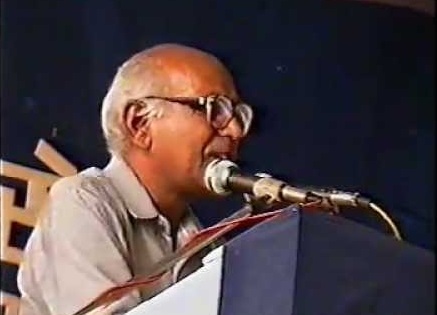
Remembering D. K. Khaparde Saheb (Founder of BAMCEF)
“Creating people who can think is a sort of revolution. BAMCEF in the last 20 years, has created such people. This is its greatest achievement.” – D. K. Khaparde
The post-Ambedkar social movement saw many great luminaries throughout India who remained true and committed to the struggle of their people. Various social movements emerged, none was as effective and successful as the BAMCEF was and the credit must go to the founders of this movement, foremost among them was D.K. Khaparde.
In the 60s, the Ambedkarite movement had to bear the deadly set back as Babasaheb Ambedkar died in 1956. People were distraught, broken, and hopeless. Their hope was gone. Many people strove to carry on the caravan based on their understanding and mental disposition, but BAMCEF was the systematic and organized attempt to respond to the situation.
D. K. Khaparde was born on 13th May 1939 in Nagpur (Maharashtra, India). D.K. Khaparde came from Anand Nagar, the bastion of Ambedkarite movement in Nagpur which gave many committed people to the movement. He was a science graduate who worked in DRDO in Pune. The first generation of the bread earner in his family was so dedicated to the movement that he did not care for his job.
D.K. Khaparde: The legacy of commitment
Khaparde had enlightened Kanshiram about the movement of Dr. Ambedkar. Saheb Kanshi Ram got an introduction to Dr. Ambedkar’s ideas from D. K. Khaparde while working at DRDO Pune. Writes, French writer, Christophe Jaffrelot in his book ‘India’s Silent Revolution: The Rise of the Lower Castes in North India’, “once again a North Indian low caste leader was to benefit from the Maharashtrian experiment, all the more so as Kanshi Ram was largely initiated into ‘Ambedkarism’ by one of his colleagues, a Mahar Buddhist, D. K. Khaparde.”
The crises on the issue of Jayanti celebration of Dr. Babasaheb Ambedkar in the Defence establishment galvanized the followers of Dr. Babasaheb Ambedkar who have decided to form an all India organization to spread the movement of Phule-Ambedkar and formed BAMCEF, which was officially launched on 6th December 1978. Later over the differences with regard to the working of BAMCEF, Kanshi Ram and Khaparde parted their ways. (It is said that Kanshi Ram wanted to make BAMCEF enter into the political sphere but Khaparde wanted it to remain a social organization hence there were conflicts.)
The contribution of D. K. Khaparde lies not only in codifying the Bahujan ideology and bringing to public the great personalities of the Bahujan Samaj but also in giving an organized structure to instrumentalize the movement. The organization like BAMCEF is the medium, instrument, and carrier of the Bahujan movement. The organization first, was his motto and organization is fundamental to the life and spread of the movement.
Popularly known as Khaparde Saheb, Saheb travelled all over India and led many cadre camps awakening and organizing people. One can relate many of the life stories of his dedication to his people. He was a voracious reader and drew his strength from his intellectual foray, but above all, he was an intellectually honest person.
Running organization and movement is perhaps the most difficult task as it involves working and interacting with fellow human beings and get along with them on the common goal. The founders have a more difficult task to keep afloat an organization, but also ensure ideological clarity and commitment to clear ideology. Khaparde Saheb was good at all these tasks.
In a surprising way, the Bahujan movement needs the same approach that BAMCEF began with even today to fight the monster of Brahminism:
1. Clear articulation of the enemies of the Bahujan Samaj
2. Exposing the trickery of the Brahminism
3. Build alliances within backward classes and exploited religious minorities
4. Continuous mobilization of masses through policy analysis, particularly social policies
5. A common platform for deliberation for all the backward classes and exploited minorities
6. Strive for a federation of backward classes institutions and organizations
7. To create a political party to channelize social movement to access power in the democratic setup
8. Cultural Revolution to counter Brahminical Nazism.
That these 8 points are still valid shows that we need to continue to live the legacy of Khaparde Saheb.
After the 16th National convention of BAMCEF in 1999 at Patna, Bihar, he suffered from abdomen cancer and succumbed to death on 29th February 2000 at Pune. He was a symbol of self sacrificed full of dedication and commitment to Phule-Ambedkar movement for the cause of the social revolution in India. Long Live Khaparde Saheb and his legacy of commitment.
Author – Mangesh Dahiwale, Human Rights Activist
Edited by – Velivada Team




I find a term Mahar Buddhist in this writing.Why the author has used this? Please educate me on this.I think this is a controversial writing.Why caste identity with Buddhism.?
it is wrong to say that Kanshiramji wanted BAMCEF to enter politics. This is absolutely wrong because since beginning Kanshiramji had kept the BAMCEF away from agitational programmes then what to talk of politics! It is a totally mis-propaganda against Kanshiramji. For politics, BSP was formed and so entering BAMCEF into politics was not at all an issue.
Jai Bhim, thank you for the comment. It could be wrong, we don’t deny that. Hence we put those words in brackets and wrote as “it is said……” With these words, we are in no way saying that it was the only reason or was the reason. It is what many people believe, that’s what we are saying. Further, even before BSP was formed DS4 has contested elections so saying BSP was formed to enter politics isn’t fully correct either as DS4 has contested elections in Delhi before BSP.